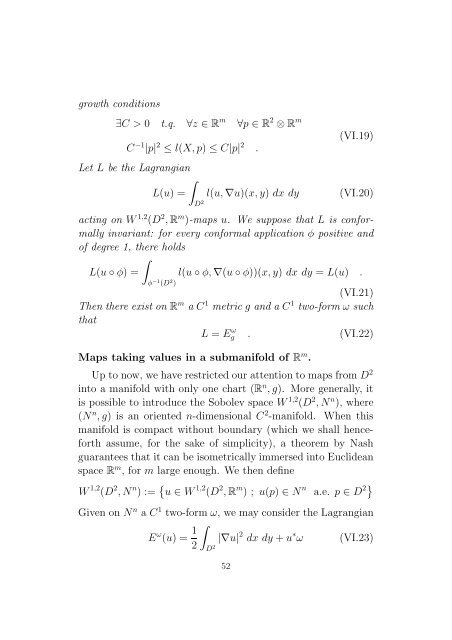Conformally Invariant Variational Problems. - SAM
Conformally Invariant Variational Problems. - SAM
Conformally Invariant Variational Problems. - SAM
You also want an ePaper? Increase the reach of your titles
YUMPU automatically turns print PDFs into web optimized ePapers that Google loves.
growth conditions<br />
∃C > 0 t.q. ∀z ∈ R m ∀p ∈ R 2 ⊗R m<br />
C −1 |p| 2 ≤ l(X,p) ≤ C|p| 2 .<br />
Let L be the Lagrangian<br />
∫<br />
L(u) = l(u,∇u)(x,y) dx dy<br />
D 2<br />
(VI.19)<br />
(VI.20)<br />
acting on W 1,2 (D 2 ,R m )-maps u. We suppose that L is conformally<br />
invariant: for every conformal application φ positive and<br />
of degree 1, there holds<br />
∫<br />
L(u◦φ) = l(u◦φ,∇(u◦φ))(x,y) dx dy = L(u) .<br />
φ −1 (D 2 )<br />
(VI.21)<br />
Then there exist on R m a C 1 metric g and a C 1 two-form ω such<br />
that<br />
L = E ω g . (VI.22)<br />
Maps taking values in a submanifold of R m .<br />
Up to now, we have restricted our attention to maps from D 2<br />
into a manifold with only one chart (R n ,g). More generally, it<br />
is possible to introduce the Sobolev space W 1,2 (D 2 ,N n ), where<br />
(N n ,g) is an oriented n-dimensional C 2 -manifold. When this<br />
manifold is compact without boundary (which we shall henceforth<br />
assume, for the sake of simplicity), a theorem by Nash<br />
guarantees that it can be isometricallyimmersed into Euclidean<br />
space R m , for m large enough. We then define<br />
W 1,2 (D 2 ,N n ) := { u ∈ W 1,2 (D 2 ,R m ) ; u(p) ∈ N n a.e. p ∈ D 2}<br />
Given on N n a C 1 two-form ω, we may consider the Lagrangian<br />
E ω (u) = 1 ∫<br />
|∇u| 2 dx dy +u ∗ ω (VI.23)<br />
2 D 2<br />
52
















